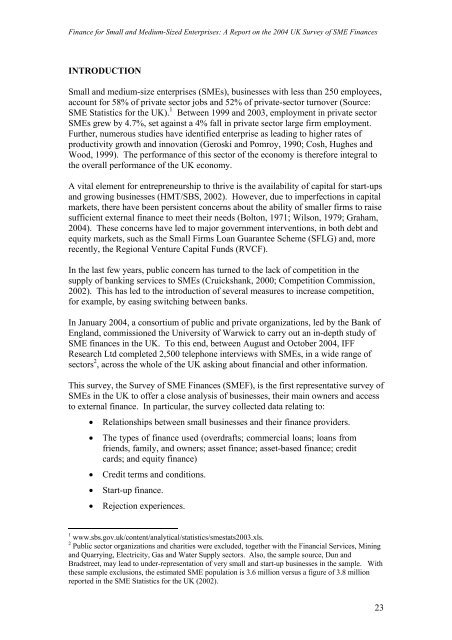Finance for Small and Medium-Sized Enterprises - DTI Home Page
Finance for Small and Medium-Sized Enterprises - DTI Home Page
Finance for Small and Medium-Sized Enterprises - DTI Home Page
Create successful ePaper yourself
Turn your PDF publications into a flip-book with our unique Google optimized e-Paper software.
<strong>Finance</strong> <strong>for</strong> <strong>Small</strong> <strong>and</strong> <strong>Medium</strong>-<strong>Sized</strong> <strong>Enterprises</strong>: A Report on the 2004 UK Survey of SME <strong>Finance</strong>s<br />
INTRODUCTION<br />
<strong>Small</strong> <strong>and</strong> medium-size enterprises (SMEs), businesses with less than 250 employees,<br />
account <strong>for</strong> 58% of private sector jobs <strong>and</strong> 52% of private-sector turnover (Source:<br />
SME Statistics <strong>for</strong> the UK). 1 Between 1999 <strong>and</strong> 2003, employment in private sector<br />
SMEs grew by 4.7%, set against a 4% fall in private sector large firm employment.<br />
Further, numerous studies have identified enterprise as leading to higher rates of<br />
productivity growth <strong>and</strong> innovation (Geroski <strong>and</strong> Pomroy, 1990; Cosh, Hughes <strong>and</strong><br />
Wood, 1999). The per<strong>for</strong>mance of this sector of the economy is there<strong>for</strong>e integral to<br />
the overall per<strong>for</strong>mance of the UK economy.<br />
A vital element <strong>for</strong> entrepreneurship to thrive is the availability of capital <strong>for</strong> start-ups<br />
<strong>and</strong> growing businesses (HMT/SBS, 2002). However, due to imperfections in capital<br />
markets, there have been persistent concerns about the ability of smaller firms to raise<br />
sufficient external finance to meet their needs (Bolton, 1971; Wilson, 1979; Graham,<br />
2004). These concerns have led to major government interventions, in both debt <strong>and</strong><br />
equity markets, such as the <strong>Small</strong> Firms Loan Guarantee Scheme (SFLG) <strong>and</strong>, more<br />
recently, the Regional Venture Capital Funds (RVCF).<br />
In the last few years, public concern has turned to the lack of competition in the<br />
supply of banking services to SMEs (Cruickshank, 2000; Competition Commission,<br />
2002). This has led to the introduction of several measures to increase competition,<br />
<strong>for</strong> example, by easing switching between banks.<br />
In January 2004, a consortium of public <strong>and</strong> private organizations, led by the Bank of<br />
Engl<strong>and</strong>, commissioned the University of Warwick to carry out an in-depth study of<br />
SME finances in the UK. To this end, between August <strong>and</strong> October 2004, IFF<br />
Research Ltd completed 2,500 telephone interviews with SMEs, in a wide range of<br />
sectors 2 , across the whole of the UK asking about financial <strong>and</strong> other in<strong>for</strong>mation.<br />
This survey, the Survey of SME <strong>Finance</strong>s (SMEF), is the first representative survey of<br />
SMEs in the UK to offer a close analysis of businesses, their main owners <strong>and</strong> access<br />
to external finance. In particular, the survey collected data relating to:<br />
• Relationships between small businesses <strong>and</strong> their finance providers.<br />
• The types of finance used (overdrafts; commercial loans; loans from<br />
friends, family, <strong>and</strong> owners; asset finance; asset-based finance; credit<br />
cards; <strong>and</strong> equity finance)<br />
• Credit terms <strong>and</strong> conditions.<br />
• Start-up finance.<br />
• Rejection experiences.<br />
1 www.sbs.gov.uk/content/analytical/statistics/smestats2003.xls.<br />
2 Public sector organizations <strong>and</strong> charities were excluded, together with the Financial Services, Mining<br />
<strong>and</strong> Quarrying, Electricity, Gas <strong>and</strong> Water Supply sectors. Also, the sample source, Dun <strong>and</strong><br />
Bradstreet, may lead to under-representation of very small <strong>and</strong> start-up businesses in the sample. With<br />
these sample exclusions, the estimated SME population is 3.6 million versus a figure of 3.8 million<br />
reported in the SME Statistics <strong>for</strong> the UK (2002).<br />
23















![Joint Report on Social Protection and Social Inclusion [2005]](https://img.yumpu.com/19580638/1/190x132/joint-report-on-social-protection-and-social-inclusion-2005.jpg?quality=85)
